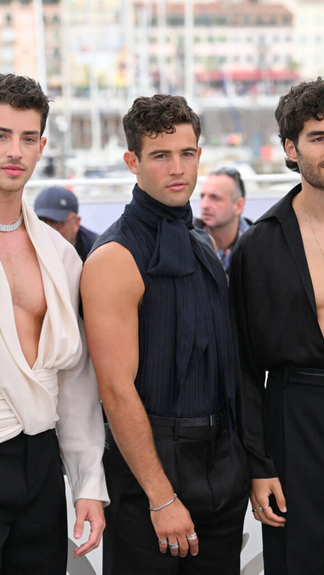Soft Masculinity And Loud Luxury Are What We Saw Rising As The New Red-carpet Archetype
- Hinton Magazine

- Jun 10
- 3 min read
Updated: Jun 11
How Cannes 2025 Signaled A Shift In Male Identity—and Why PR Strategist Kiko Gaspar Believes Softness Is The New Status Symbol.
The red carpet is no longer a battleground for rigid masculinity; it has become a playground for softness, vulnerability, and high-impact storytelling. As the 2025 Cannes Film Festival wrapped up this week, one straightforward narrative emerged from the flashbulbs and velvet ropes: the rise of a new masculine aesthetic, where softness is not weakness but a statement, and luxury is expressed in a language of lace, pearls, and poetic tailoring.
Credits: Instagram
Actors like Barry Keoghan and Manu Ríos weren’t just dressed — they were styled to make a statement. Barry Keoghan captivated audiences in a Burberry ensemble featuring a powder-blue blazer with black lapels, paired with a ruffled white shirt and tailored trousers. This look blended classic tailoring with romantic elements, challenging conventional masculine norms and signaling an embrace of theatricality that feels profoundly modern. Manu Ríos, known for his role in Netflix’s Elite, donned a flowing, open-chested ivory blouse paired with high-waisted black trousers and a diamond choker. His attire exuded a blend of sensuality and elegance, further pushing the boundaries of men’s fashion while offering an image that is both emotionally magnetic and unapologetically performative.
“This is not about androgyny as a gimmick,” says Kiko Gaspar, PR strategist and cultural analyst. “What we’re seeing is a deliberate reinvention of what power dressing means for men. These looks are emotionally intelligent. They aren’t trying to seduce tradition — they’re replacing it.”
It wasn’t just these two stars redefining the male gaze. Josh O’Connor’s color-blocked suit and oversized floral brooch, and Alexander Skarsgård’s Saint Laurent thigh-high boots and structured tailoring, further pushed the aesthetic. Gone is the binary of ‘classically tailored’ versus ‘campy fashion risk.’ In its place is an elegant hybridity — part romantic hero, part algorithm disruptor.
This aesthetic shift reflects deeper cultural movements. Gen Z is actively dismantling inherited codes of masculinity. Social media platforms, particularly TikTok and Pinterest, are accelerating what Gaspar calls “a visual democratization of softness.” The result is a generation that craves texture, storytelling, and emotional nuance — even in a tuxedo.
“Gen Z doesn’t want masculinity with sharp edges. They want it with a thesis,” Gaspar notes. “And what we’re seeing on the red carpet is brands catching up — or risking irrelevance.”
Luxury houses are taking note. Brands like Gucci, Burberry, Loewe, and even heritage lines like Valentino are blurring gender binaries with fluid fabrics, embroidered detailing, and campaigns featuring emotionally expressive male leads. What was once labeled “gender-bending” is now just strategy — and a commercially smart one at that.
The influence doesn’t stop at fashion. Advertising is shifting toward emotionally resonant portrayals of men, not just strong, but sensitive; not just aspirational, but self-aware. From skincare ads that emphasize softness as a sign of strength to fragrance campaigns rooted in intimacy and nostalgia, “soft power” has become the new currency.
Meanwhile, the media is mirroring the movement. From Netflix dramas featuring emotionally articulate male protagonists to the rise of “quiet luxury” influencers with unpolished vulnerability, the media landscape is building a new masculine mythology — less James Bond, more Paul Mescal.
For Kiko Gaspar, the shift is not merely a trend but a communications pivot. “What we’re seeing isn’t a rejection of masculinity — it’s an expansion. This is masculinity as a moodboard. It’s editorial. It’s soft, but never small.”
The red carpet, once the last frontier of stoic male fashion, is now a runway for redefinition. And as Cannes 2025 closes with a flurry of pearls, ruffles, and unapologetic self-expression, it’s clear that the archetype of the modern man has changed — not by accident, but by aesthetic revolution.
.png)
_edited.jpg)


















Comments